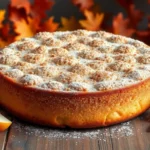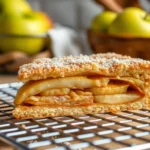There’s something magical about the perfect balance of chewy oats and melted chocolate chips that makes oatmeal chocolate chip cookies irresistible. We’ve all experienced that moment when the aroma of freshly baked cookies fills the kitchen and suddenly everyone gravitates toward the source of that heavenly scent.
These aren’t just any ordinary cookies – they’re the ultimate comfort food that combines wholesome oats with rich chocolate chips to create a texture that’s both satisfying and indulgent. The beauty of oatmeal chocolate chip cookies lies in their versatility: they’re sturdy enough for lunchboxes yet sophisticated enough for dessert platters.
We’ve perfected this recipe to deliver cookies with crispy edges and chewy centers that’ll have your family asking for seconds before they’ve finished their first bite. Whether you’re baking for a special occasion or simply craving homemade goodness these cookies deliver every single time.
Ingredients
We’ve carefully selected each ingredient to create the perfect balance of textures and flavors in our oatmeal chocolate chip cookies. These pantry staples combine to deliver those coveted crispy edges and chewy centers that make these cookies irresistible.
Dry Ingredients
- 1 cup all-purpose flour
- 1 teaspoon baking soda
- 1 teaspoon ground cinnamon
- 1/2 teaspoon salt
- 3 cups old-fashioned rolled oats
Wet Ingredients
- 1 cup unsalted butter, softened to room temperature
- 1 cup packed light brown sugar
- 1/2 cup granulated sugar
- 2 large eggs, at room temperature
- 2 teaspoons vanilla extract
Mix-ins
- 1 1/2 cups semi-sweet chocolate chips
- 1/2 cup chopped walnuts (optional)
Equipment Needed

Creating our perfect oatmeal chocolate chip cookies requires the right tools to achieve those coveted crispy edges and chewy centers. We recommend gathering these essential pieces of equipment before starting our baking process.
Stand Mixer or Hand Mixer serves as our most important tool for properly creaming the butter and sugar mixture. This equipment ensures we achieve the light and fluffy texture that creates the perfect cookie foundation.
Large Bowl provides ample space for combining all our ingredients without creating a mess. We use this for mixing the dry ingredients and later incorporating them with our wet mixture.
Parchment Paper or Nonstick Baking Sheets prevents our cookies from sticking and ensures even browning. These liners also make cleanup significantly easier after our baking session.
Baking Sheets form the foundation for our cookie baking process. We recommend using heavy duty sheets that distribute heat evenly across the surface.
2-Tablespoon Scoop helps us portion our cookie dough consistently. This tool ensures uniform cookie sizes that bake evenly and look professional.
Cooling Rack allows proper air circulation around our freshly baked cookies. We transfer our cookies here immediately after baking to prevent overcooking from residual heat.
| Equipment | Purpose | Essential Level |
|---|---|---|
| Stand/Hand Mixer | Creaming butter and sugar | High |
| Large Bowl | Mixing ingredients | High |
| Parchment Paper | Preventing sticking | Medium |
| Baking Sheets | Cookie baking surface | High |
| 2-Tablespoon Scoop | Consistent portioning | Medium |
| Cooling Rack | Proper cooling | High |
Having these tools ready streamlines our baking process and helps us achieve bakery quality results every time we make these beloved cookies.
Instructions

Now that we have our ingredients measured and equipment ready, let’s walk through each step to create these bakery-quality oatmeal chocolate chip cookies. We’ll break down the process into manageable stages to ensure perfect results every time.
Prep the Oven and Baking Sheets
We start by preheating our oven to 350°F to ensure even baking temperature throughout the cooking process. Line our heavy-duty baking sheets with parchment paper to prevent the cookies from sticking and promote easy removal. Position the racks in the upper and lower thirds of the oven for optimal heat circulation when baking multiple batches.
Mix the Dry Ingredients
In a medium bowl, we whisk together 1 1/4 cups all-purpose flour, 1/2 teaspoon baking soda, 1/2 teaspoon salt, and 1/2 teaspoon ground cinnamon until evenly distributed. This dry mixture creates the foundation for our cookie structure and ensures all leavening agents are properly incorporated. Set this bowl aside while we prepare the wet ingredients.
Cream Butter and Sugars
Using our stand mixer or hand mixer, we beat 1/2 cup softened unsalted butter with 3/4 cup packed light brown sugar and 1/4 cup granulated sugar on medium speed for 2-3 minutes. The mixture should become light and fluffy with a pale color, indicating proper aeration. Scrape down the sides of the bowl as needed to ensure even mixing.
Add Wet Ingredients
We crack 1 large egg into the creamed butter mixture and add 2 teaspoons pure vanilla extract. Beat on medium speed for another minute until the ingredients are fully incorporated and the mixture appears smooth. The egg binds our ingredients together while the vanilla enhances the overall flavor profile.
Combine Wet and Dry Mixtures
With our mixer on low speed, we gradually add the dry ingredient mixture to the wet ingredients. Mix just until the flour disappears and the dough comes together, being careful not to overmix which can lead to tough cookies. Stop mixing as soon as we no longer see streaks of flour.
Fold in Oats and Chocolate Chips
We gently stir in 1 1/2 cups old-fashioned rolled oats and 1 cup semi-sweet chocolate chips using a wooden spoon or large spatula. Fold these mix-ins until they’re evenly distributed throughout the dough. If desired, we can chill the dough for 30 minutes to make it easier to handle and prevent excessive spreading during baking.
Shape and Bake the Cookies
Using our 2-tablespoon scoop, we portion the dough into uniform balls and place them 2 inches apart on our prepared baking sheets. Bake for 9-11 minutes until the edges are lightly golden brown but the centers still appear slightly underbaked. Remove from the oven and let the cookies cool on the baking sheet for 5 minutes before transferring to our cooling rack. The residual heat will finish cooking the centers while maintaining that perfect chewy texture we’re after.
Storage Tips
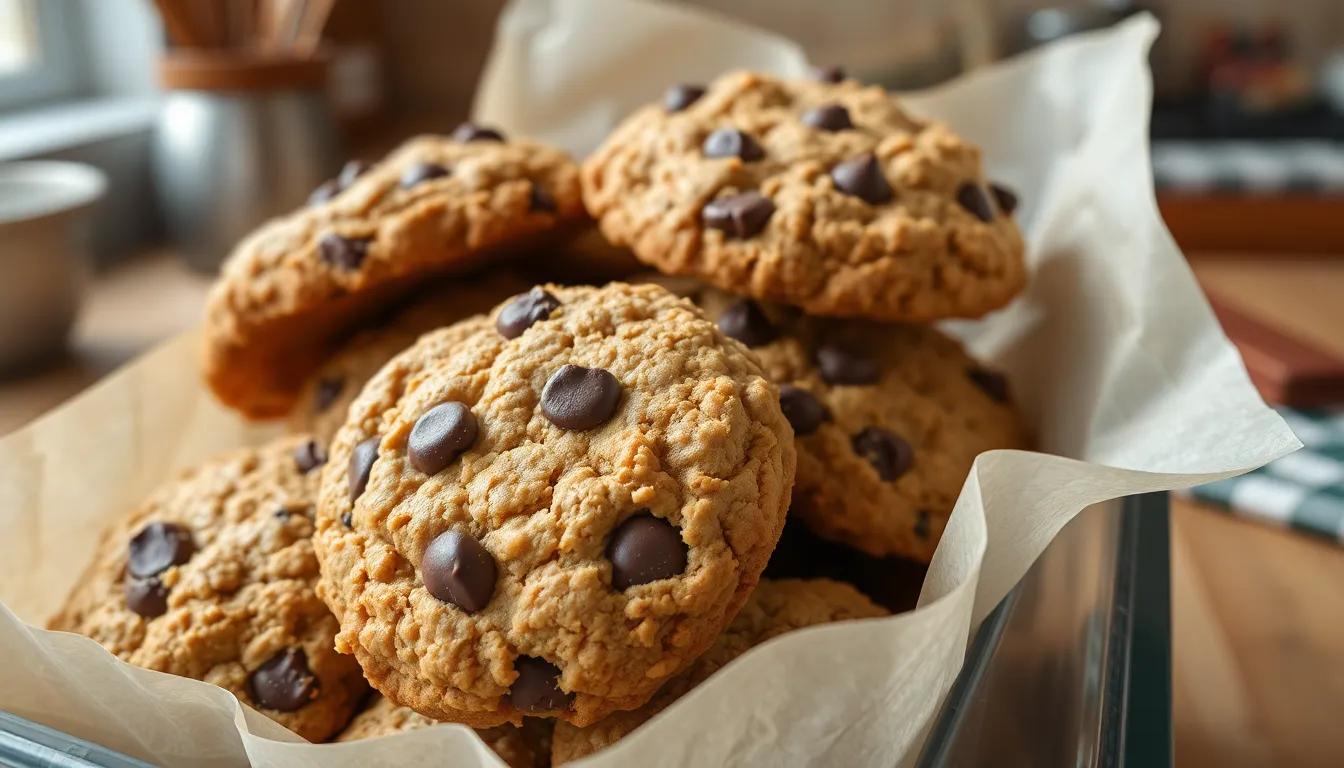
Storing your freshly baked oatmeal chocolate chip cookies properly ensures they maintain their delicious flavor and perfect texture for weeks to come. We recommend keeping these treats in an airtight container at room temperature where they’ll stay fresh for up to two weeks.
Preventing Cookies from Sticking Together
Layer your cookies carefully to prevent them from sticking together and losing their shape. We suggest arranging them in a single row and separating each layer with parchment paper, plastic wrap, or wax paper before sealing the container. This method prevents the cookies from drying out while maintaining their ideal texture.
Room Temperature Storage Method
Soft oatmeal chocolate chip cookies benefit most from airtight storage at room temperature. If your cookies lose some of their softness over time, we can refresh them by microwaving for a few seconds. Crispy cookies may lose some crunch when stored airtight, but this approach still preserves their flavor and prevents staleness.
Freezing Baked Cookies
For longer storage, we can freeze our baked cookies for up to three months. Arrange the cookies in layers within an airtight, freezer-safe container or zip-top bag, placing parchment paper between each layer. Squeeze out excess air before sealing to prevent freezer burn. Thaw the cookies at room temperature or in the refrigerator before serving.
Freezing Cookie Dough
Unbaked cookie dough stores beautifully in the freezer for future baking sessions. We scoop the dough into balls and freeze them until solid on a tray, then transfer to a freezer bag with excess air removed. The dough keeps for up to three months using this method. When ready to bake, thaw the dough in the refrigerator overnight and adjust baking time as needed.
| Storage Method | Duration | Temperature | Container Type |
|---|---|---|---|
| Room Temperature (Baked) | Up to 2 weeks | Room temperature | Airtight container |
| Frozen (Baked) | Up to 3 months | Freezer | Freezer-safe container/bag |
| Frozen (Dough) | Up to 3 months | Freezer | Freezer bag |
Proper storage techniques ensure our oatmeal chocolate chip cookies remain flavorful and maintain their desired texture whether soft and chewy or crispy for the longest possible time.
Variations and Substitutions
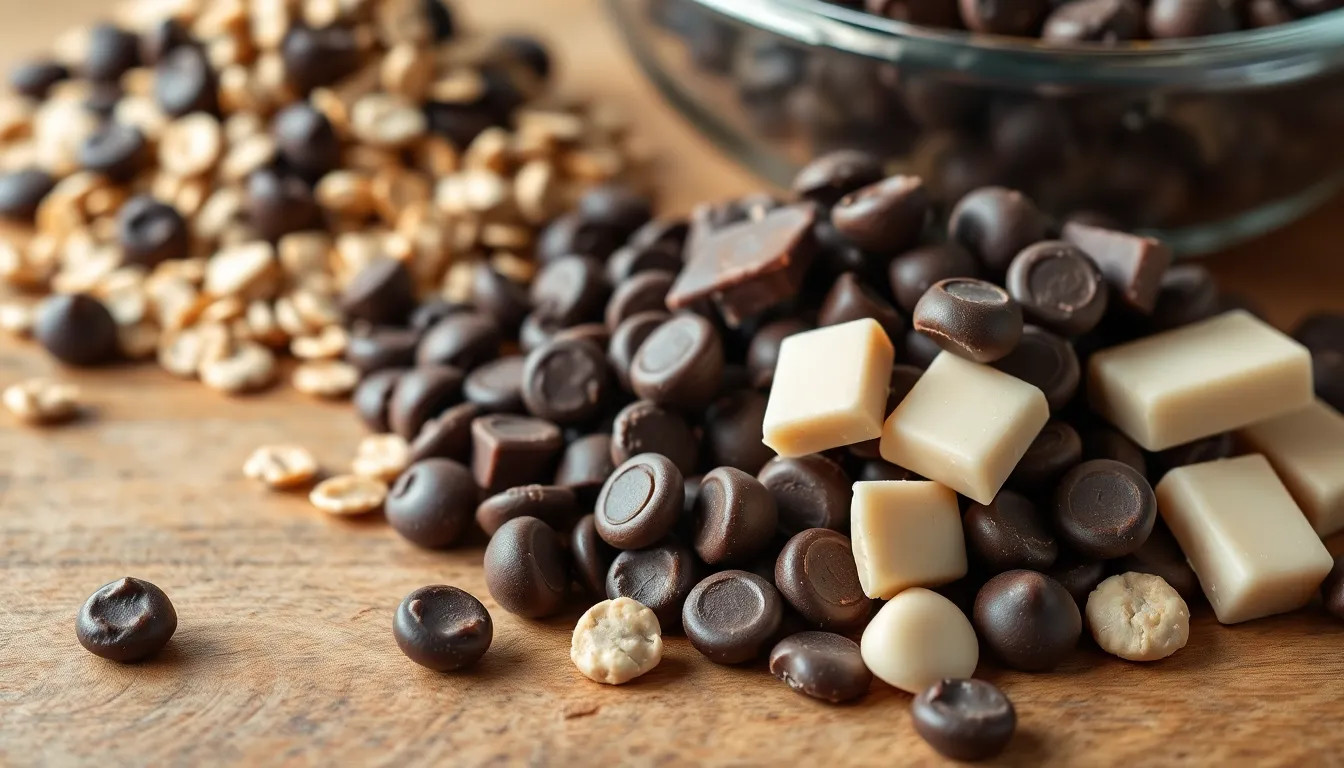
We can easily customize our oatmeal chocolate chip cookies to suit different dietary needs and flavor preferences. These adaptations maintain the beloved texture and taste while accommodating various requirements.
Different Chocolate Options
Semisweet vs. Milk Chocolate: While semisweet chocolate chips serve as our standard choice, milk chocolate creates a sweeter profile that appeals to those who prefer milder cocoa flavors. Dark chocolate chips offer a more intense, sophisticated taste for chocolate lovers seeking depth.
White Chocolate Alternative: White chocolate chips provide a creamy sweetness that pairs beautifully with the oats’ nutty flavor, creating an elegant variation perfect for special occasions.
Chocolate Chunks: We recommend using chopped chocolate instead of chips when we want more even chocolate distribution throughout each cookie. This technique creates pockets of melted chocolate that enhance every bite.
| Chocolate Type | Flavor Profile | Best For |
|---|---|---|
| Semisweet | Balanced sweet and cocoa | Classic preference |
| Milk Chocolate | Sweet and creamy | Kid-friendly option |
| Dark Chocolate | Rich and intense | Adult preference |
| White Chocolate | Sweet and vanilla notes | Special occasions |
Gluten-Free Version
Flour Replacement: We substitute traditional wheat flour with gluten-free all-purpose flour blends that include xanthan gum for optimal texture. This ingredient ensures our cookies maintain their chewy consistency without becoming crumbly.
Liquid Adjustments: Some gluten-free flour blends absorb moisture differently than wheat flour, so we may need to adjust our liquid ingredients slightly. We add one tablespoon of milk or water if the dough appears too dry.
Oat Consideration: We must verify that our rolled oats carry gluten-free certification, as traditional oats often experience cross-contamination during processing.
Vegan Adaptations
Egg Substitution: We replace each egg with one flax egg (1 tablespoon ground flaxseed mixed with 3 tablespoons water, rested for 5 minutes). Alternatively, we can use 1/4 cup mashed banana or unsweetened applesauce per egg for added moisture.
Butter Replacement: Vegan butter or coconut oil works perfectly in place of traditional butter. We use the same measurements and ensure the substitute reaches room temperature for proper creaming with sugars.
Chocolate Verification: We carefully select vegan-friendly chocolate chips, as many conventional brands contain milk derivatives. Reading ingredient labels ensures our cookies remain completely plant-based.
Texture Maintenance: These substitutions may slightly alter our cookies’ texture, but proper chilling of the dough for 30 minutes before baking helps maintain the desired consistency.
Tips for Perfect Oatmeal Chocolate Chip Cookies
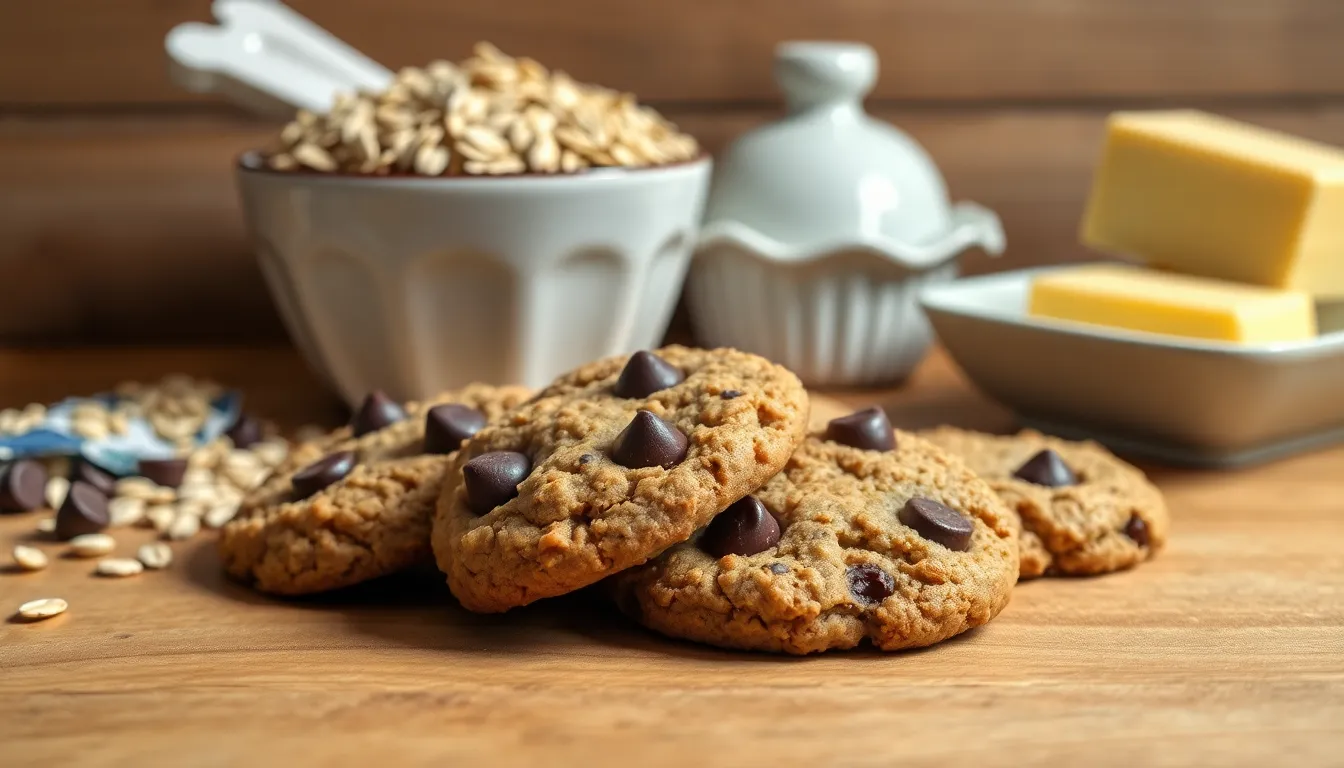
Choosing the Right Oats
Old-fashioned oats deliver superior texture compared to their quick-cooking counterparts. These larger oat flakes provide a delightfully chewy texture that defines perfect oatmeal cookies. Quick-cooking oats work in a pinch but yield softer cookies with less distinct oat presence. We recommend sticking with old-fashioned rolled oats for the best results.
Improving Flavor and Texture
Brown butter transforms ordinary cookies into extraordinary treats. This technique adds rich nutty complexity that elevates the entire flavor profile. Heat butter in a small saucepan until it turns golden brown and releases a fragrant aroma. Add one tablespoon of milk to replace moisture lost during the browning process.
Chilling cookie dough before baking prevents excessive spreading during cooking. Refrigerate shaped dough balls for at least 30 minutes to achieve thicker cookies with better texture. This step creates chewier centers while maintaining those coveted crispy edges.
Baking Techniques
Temperature control determines your cookie’s final texture. Baking at 350°F produces chewier centers with golden edges. Higher temperatures around 375°F create crispier cookies with more pronounced browning. We prefer the lower temperature for optimal texture balance.
| Temperature | Result |
|---|---|
| 350°F | Chewier centers, golden edges |
| 375°F | Crispier texture, more browning |
Proper doneness assessment prevents overbaking these naturally soft cookies. Look for lightly golden edges while centers remain soft and slightly underdone. Cookies continue cooking on hot baking sheets after removal from the oven. They may appear undercooked due to their inherently chewy nature.
Additional Tips
Accurate flour measurement prevents tough cookies that lack proper texture. Spoon flour into measuring cups rather than scooping directly from the container. Level with a knife for precision. Overpacking flour creates dense cookies that lose their tender crumb.
Creative add-ins customize cookies for different preferences and occasions. Chopped walnuts provide satisfying crunch alongside chocolate chips. Dried cranberries or raisins add chewy sweetness. Toffee bits contribute buttery caramel notes that complement the oat base perfectly.
Conclusion
We’ve shared everything you need to create bakery-quality oatmeal chocolate chip cookies that’ll become your go-to recipe. These cookies strike the perfect balance between wholesome oats and indulgent chocolate while delivering that coveted chewy texture everyone craves.
With our detailed guidance on ingredients equipment and techniques you’re equipped to avoid common baking pitfalls and achieve consistent results every time. Whether you stick to the classic recipe or experiment with our suggested variations these cookies will quickly become a household favorite.
The beauty of this recipe lies in its versatility and reliability. You can customize it to suit dietary needs or personal preferences while still maintaining that perfect chewy center and golden exterior we all love.
Start baking today and discover why oatmeal chocolate chip cookies remain one of America’s most beloved treats!
Frequently Asked Questions
What makes oatmeal chocolate chip cookies different from regular chocolate chip cookies?
Oatmeal chocolate chip cookies feature old-fashioned rolled oats that create a heartier texture and more complex flavor. The oats provide additional chewiness and a subtle nutty taste, while also adding nutritional value with extra fiber and protein compared to traditional chocolate chip cookies.
How long do oatmeal chocolate chip cookies stay fresh?
When stored in an airtight container at room temperature, oatmeal chocolate chip cookies remain fresh for up to two weeks. For longer storage, you can freeze them for up to three months. Proper storage maintains their chewy texture and prevents them from becoming stale.
Can I make these cookies gluten-free?
Yes, you can make gluten-free oatmeal chocolate chip cookies by substituting the all-purpose flour with a 1:1 gluten-free flour blend. Ensure your oats are certified gluten-free, as regular oats may be cross-contaminated during processing. The texture and taste remain deliciously similar to the original recipe.
Why should I chill the cookie dough before baking?
Chilling the dough for at least 30 minutes helps prevent excessive spreading during baking, resulting in thicker cookies with better shape retention. Cold dough also allows flavors to meld together and creates a more controlled baking process, leading to cookies with crispy edges and chewy centers.
What’s the secret to achieving the perfect chewy texture?
The key to perfectly chewy oatmeal chocolate chip cookies is slightly underbaking them. Remove cookies when edges are golden brown but centers still look slightly underdone. They’ll continue cooking on the hot pan while cooling, creating that ideal chewy texture everyone loves.
Can I substitute ingredients to make the cookies healthier?
Absolutely! You can reduce sugar by up to 25%, substitute half the butter with applesauce, or use whole wheat flour for added fiber. Dark chocolate chips provide antioxidants, and adding nuts contributes healthy fats and protein while maintaining the cookies’ delicious taste.
What equipment do I need to make perfect oatmeal chocolate chip cookies?
Essential equipment includes a stand or hand mixer, mixing bowls, heavy-duty baking sheets, parchment paper, a 2-tablespoon scoop for uniform sizing, and a cooling rack. Quality baking sheets ensure even heat distribution, while proper measuring tools guarantee consistent results every batch.
How do I prevent my cookies from turning out too dry or tough?
Avoid overmixing the dough once flour is added, as this develops gluten and creates tough cookies. Measure flour accurately using the spoon-and-level method, and don’t overbake. Slightly underdone cookies will have the perfect tender, chewy texture once they finish cooking on the cooling rack.




